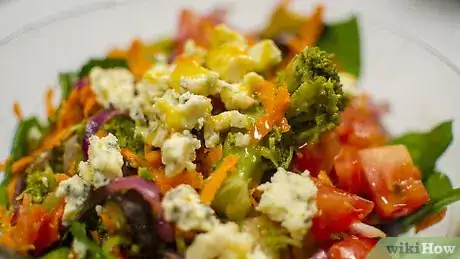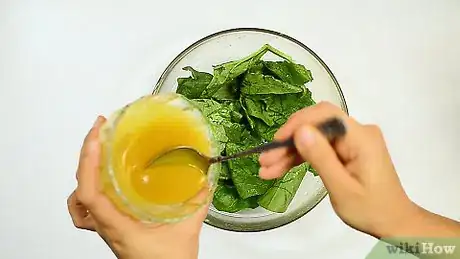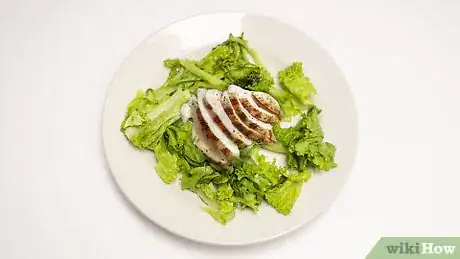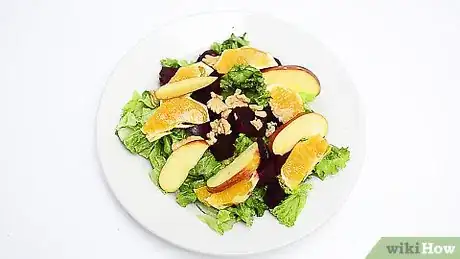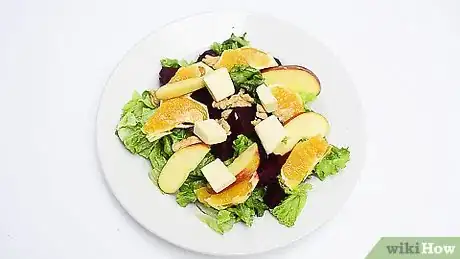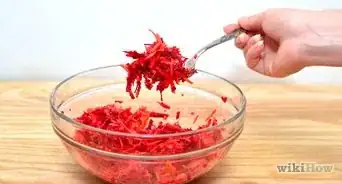This article was co-authored by wikiHow staff writer, Hunter Rising. Hunter Rising is a wikiHow Staff Writer based in Los Angeles. He has more than three years of experience writing for and working with wikiHow. Hunter holds a BFA in Entertainment Design from the University of Wisconsin - Stout and a Minor in English Writing.
There are 10 references cited in this article, which can be found at the bottom of the page.
The wikiHow Video Team also followed the article's instructions and verified that they work.
This article has been viewed 44,109 times.
Learn more...
Dressing a salad means adding a liquid flavoring to your greens and vegetables. Whether you use a bottled dressing or make a simple dressing of your own, knowing how to dress a salad properly turns you from good cook into a great cook!
Ingredients
Simple Vinaigrette Dressing
- 3 tablespoons (44 ml) of olive oil
- 1 tablespoon (15 ml) of vinegar
- Salt and pepper to taste
Makes 1 serving
Homemade Ranch Dressing
- ½ cup (115 g) of mayonnaise
- ½ cup (115 g) of sour cream
- 1⁄2 cup (120 ml) of buttermilk
- 1 teaspoon (0.53 g) of dried dill
- ½ teaspoon (0.27 g) of dried parsley
- ½ teaspoon (0.27 g) of dried chives
- ¼ teaspoon (1.6 g) of onion powder
- ½ teaspoon (1.6 g) of garlic powder
- ¼ teaspoon (1.25 g) of sea salt
- ⅛ teaspoon (0.23 g) of cracked black pepper
- 1–3 teaspoons (4.9–14.8 ml) of lemon juice (to taste)
Makes 1 1⁄2 cups (350 ml)
Zesty Italian Dressing
- 1⁄2 cup (120 ml) of olive oil
- 1⁄4 cup (59 ml) of white vinegar
- 2 tablespoons (30 ml) of water
- 2 teaspoons (14 g) of honey
- 1 teaspoon (4.9 ml) of lemon juice
- 3 tablespoons (15 g) of grated parmesan cheese
- ¾ teaspoon (2.4 g) of garlic salt
- ¾ teaspoon (0.4 g) of dried parsley
- ⅛ teaspoon (0.07 g) of dried oregano
- ¾ teaspoon (0.4 g) of dried basil
- 1 pinch of red pepper flakes
- Salt and pepper to taste
Makes 1 cup (240 ml)
Steps
Using a Light Dressing
-
1Pour the dressing into the bottom of a mixing bowl. Swirl the bowl so the dressing lines the bottom and sides. A lighter dressing mixes easily and this way you know how much dressing you're using right away.[1]
- Start with a small amount of dressing. It's easier to add more, but difficult to remove.
- This works best with lighter dressings, like Italian or vinaigrettes.
-
2Put your salad greens in the bowl before any toppings. Layer your ingredients so the heavier, sturdier ingredients are on the bottom of the bowl. The greens will absorb most of the dressing's flavor and won't drown out your other toppings.[2]
- Leave out crunchy toppings that could get soggy, like croutons or bacon bits.
Advertisement -
3Stir the salad gently with your hands. Wash your hands before handling your salad. Carefully rotate the salad between your fingers so your dressing coats the salad evenly. You want your greens to have a light coating rather than being drenched.[3]
- Tongs will bruise and brown your greens, making them less crisp.
- Wear gloves if you want to avoid getting your hands messy.
-
4Add any additional toppings after you mix your salad. If you want to add crunch to your salad with croutons, wait until after you've mixed in your dressing. This prevents them from getting soggy before you eat them.
Mixing in a Heavier Dressing
-
1Put your greens in the bowl first. Thicker dressings work best with sturdy greens like iceberg lettuce, endive, or kale. Only adding your base greens will help coat the main part of your salad with dressing without overpowering any of the toppings.[4]
- Do this if you're using creamy dressings, such as blue cheese, Caesar, or ranch.
- Dry your greens before mixing them in or else the dressing will run off of them.
-
2Add a small amount of the dressing and mix it in with your hands. Work with 1⁄2 tablespoon (7.4 ml) of the dressing at a time. Use your hands to gently toss the dressing through the greens until they are evenly coated. If some of the greens are still dry after adding dressing, put in another 1⁄2 tablespoon (7.4 ml).[5]
- Don't add too much dressing right away or your salad may get soggy.
-
3Pour your toppings on the salad once the dressing has been mixed. After you coat the greens with a thin layer of dressing, put in whatever toppings you want to include. Give your salad a final toss to get some of the dressing on your toppings.[6]
- Add a pinch of salt to your salad to bring out the flavors and soften tougher greens.
Making Your Own Dressing
-
1Mix together a simple vinaigrette. Combine 3 tablespoons (44 ml) of olive oil with 1 tablespoon (15 ml) of your choice of vinegar. You could use balsamic, white wine, or plain white vinegar for your dressing. Whisk the oil and vinegar together to combine them. Add salt and pepper a pinch at a time, whisking them in thoroughly with your dressing. Taste the vinaigrette when it's mixed and adjust any flavors.[7]
- Olive oil can be substituted with any other cooking oil, such as walnut, avocado, or coconut oil.
- Add lemon or lime juice to your vinaigrette to give it an acidic kick.
- The oil and vinegar will separate if you let it sit. If you make more vinaigrette than you plan on using right away, make sure to mix it together before using it again.
-
2Whisk together homemade buttermilk ranch dressing. Put mayonnaise, sour cream, and buttermilk into a large mixing bowl and whisk them together until it has a smooth consistency. Add the dill, parsley, chives, onion and garlic powder, sea salt and pepper. Mix the herbs and spices until they are evenly distributed. Add the lemon juice to the dressing and whisk it one final time.[8]
- Substitute white vinegar for the lemon juice if you want. Either will add tang to your dressing.
- Store the dressing is a sealed jar for 1 week in the fridge.
-
3Make an Italian dressing for a zesty flavor. Place the olive oil, vinegar, water, honey, and lemon juice in a jar or resealable container. Mix the parmesan cheese, garlic salt, parsley, basil, oregano, and red pepper flakes in a separate bowl before adding them to the liquids. Shake the container to mix the dressing together. Taste the dressing and add salt and pepper to adjust the flavor.[9]
- Adjust the amount of honey you add if you want your dressing to be more or less acidic.
- Keep the dressing in the fridge, but allow it to come to room temperature before serving it.
Preparing Your Salad from Scratch
-
1Chop your greens using a chef's knife. You can use spinach, arugula, or classic iceberg lettuce as the base for your salad. Cut the pieces of lettuce into 1⁄2 inch (1.3 cm) squares for a chopped salad or leave it larger to look more natural.[10]
- Avoid using any limp or yellowed greens.
-
2Dry the greens using a salad spinner or a plastic bag. Shake any excess water off the leaves before placing them in the spinner or bag. Pull the handle on the spinner to remove the rest of the water from your greens. Continue spinning them until they are dry.[11]
- When using a plastic bag, line the bottom of the bag with 2-3 paper towels. Put your greens inside it and spin the bag over your head several times until the salad is dry.
- Refrigerate an undressed salad for up to 3 hours to keep it crisp. You can either transfer the salad to a different bowl or keep it in the salad spinner.
-
3Put bacon or chicken on your salad for a more filling meal. Cook the meat thoroughly before adding it on top of your salad. Leave the meat in strips for a fancy looking topping or cube it to mix it into the rest of the salad.[12]
- Precooked bacon bits can be purchased at the grocery store either in the spice section or near the salad dressings.
- Use grilled meats rather than fried meats to keep your salads healthy.
-
4Sprinkle walnuts on top to add fat and non-meat protein. You can use either whole walnuts or chop them to spread them throughout your salad. Place a few walnuts on the plate so you have a source of healthy fats and proteins in your meal.[13]
- Use candied walnuts to add a hint of sweetness to your salad!
-
5Line the salad with fresh fruit. Slice blueberries, strawberries, or oranges to line the outside of the salad if it's on a plate or on top if it's in a bowl. Adding fruit will give the salad some sweetness as well as some acidity.[14]
- Adding fruit will add color and brightness to the plate as well as enhance the flavor of your salad
-
6Crumble feta or goat cheese on top to add fat to the dish. Pinch the feta in between your fingers to evenly sprinkle it on top of your salad. The cheese will add a flavor of creaminess and help further balance the dish.[15]
- Use shredded cheddar or parmesan as an alternative to feta or goat cheese.
-
7Top the salad with croutons for crunch. Croutons are cubed pieces of baked bread often spiced with herbs to add flavor and crunch to your salads. Use a small handful after you've dressed your salad to give your salad a different texture.[16]
- You can either buy pre-packaged croutons or make your own at home.
Community Q&A
-
QuestionShould I add the dressing just before eating or let it refrigerate with the dressing on?
 Community AnswerFor the majority of salads, you will want to add the dressing just before you eat it. (Some salads are better if left to sit in the dressing, but a recipe will usually specify this. Other salads will get soggy.)
Community AnswerFor the majority of salads, you will want to add the dressing just before you eat it. (Some salads are better if left to sit in the dressing, but a recipe will usually specify this. Other salads will get soggy.)
Things You'll Need
Using a Light Dressing
- Mixing bowl
Mixing in a Heavier Dressing
- Mixing bowl
Making Your Own Dressing
- Measuring spoons
- Mixing bowl
- Whisk
Preparing Your Salad from Scratch
- Chef's knife
- Salad spinner or plastic bag
- Paper towel
References
- ↑ https://www.tastingtable.com/cook/national/how-to-dress-a-salad-thin-salad-dressing-thick-salad-dressing
- ↑ https://www.tastingtable.com/cook/national/how-to-dress-a-salad-thin-salad-dressing-thick-salad-dressing
- ↑ https://www.bonappetit.com/story/how-to-dress-a-salad
- ↑ https://www.tastingtable.com/cook/national/how-to-dress-a-salad-thin-salad-dressing-thick-salad-dressing
- ↑ https://www.tastingtable.com/cook/national/how-to-dress-a-salad-thin-salad-dressing-thick-salad-dressing
- ↑ https://www.tastingtable.com/cook/national/how-to-dress-a-salad-thin-salad-dressing-thick-salad-dressing
- ↑ https://www.thekitchn.com/how-to-make-a-basic-vinaigrette-226699
- ↑ https://barefeetinthekitchen.com/homemade-ranch-salad-dressing/
- ↑ https://www.fivehearthome.com/homemade-italian-salad-dressing-better-than-olive-garden-copycat-recipe/
- ↑ https://www.bonappetit.com/story/how-to-dress-a-salad
- ↑ https://www.bonappetit.com/story/how-to-dress-a-salad
- ↑ https://barefeetinthekitchen.com/how-to-eat-salad-every-day/
- ↑ https://youtu.be/pOgI52lY9-c?t=1m44s
- ↑ https://youtu.be/pOgI52lY9-c?t=1m22s
- ↑ https://youtu.be/pOgI52lY9-c?t=1m41s
- ↑ https://www.thekitchn.com/croutons-to-pine-nuts-10-favor-141515
